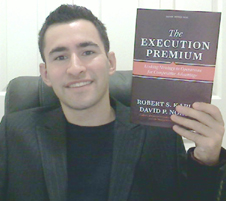Today, I spoke to Robert S. Kaplan, who is a Harvard University professor, as well as the chairman of the Palladium Group, Inc and the author of many books, including his latest called “The Execution Premium.” As you read this discussion, think about ways you can apply these business strategies in your own life. Robert has an abundance of knowledge in this area and you are guaranteed to learn a great deal with this blog post.
One example of how Robert’s comments are relevant to your personal brand is that we all need to have values, as well as a vision and mission statements. Many of these strategies can be incorporated in our own development plan and at the end of this conversation, Robert talks about how he manages multiple hats.
Why do so many companies have a hard time actually executing their business strategies? Why do people fail to act?
A key issue is to recognize that strategy and operations (or tactics) are both important but they are different. The normal course of events is for companies to focus on day-to-day operations and short-term problem solving. This is reinforced by their short-term financial measurement system, based on the annual budget. Management meetings focus on budget shortfalls, fighting fires and fixing problems. Often little time and few resources get committed to strategic issues.
We don’t advocate abandoning an intense focus on operations and their improvement. But we do advocate that planning strategy, not just describing it is important, and that the senior management team needs to have regular, probably monthly, meetings that focus only on strategy. We describe in the book the different roles, frequencies, participants, and agendas for operational review meetings and strategy review meetings. We open the book with a great quote “Strategy without tactics is the long road to victory; Tactics without strategy is the noise before defeat” (often but perhaps inaccurately attributed to Sun Tzu, The Art of War). This quote highlights the importance of integrating strategy and operations, a central theme in our strategy execution system.
What tools are available to develop an effective and successful business strategy?
Before formulating a strategy, managers need to agree on their company’s purpose (mission), its aspiration for future results (vision), and the internal compass that will guide its actions (values).
The mission is a brief statement, typically one or two sentences, that defines why the organization exists, especially what it offers to its customers and clients. Novartis, the global pharmaceutical company, presents a good example: “We want to discover, develop and successfully market innovative products to prevent and cure diseases, to ease suffering and to enhance the quality of life. We also want to provide a shareholder return that reflects outstanding performance and to adequately reward those who invest ideas and work in our company.”
The vision is a concise statement that defines the mid- to long-term (three- to 10-year) goals of the organization. CIGNA Property and Casualty, an insurance company division we worked with in the 1990s, stated its goal this way: “to be a top-quartile specialist within 5 years.” Though short, this vision statement contained three vital components:
- Stretch goal: “top quartile” in profitability (at the time Cigna P&C was at the bottom of the fourth quartile).
- Definition of market focus: “a specialist,” not a general-purpose underwriter, as it was at the time.
- A time line for execution: “5 years” (a heartbeat in the slow-moving insurance industry).
The stretch goal in the vision statement should truly be a difficult reach for the company in its present position.
Finally, the values (often called core values) of a company prescribe the attitude, behavior, and character of an organization. Value statements, which are often lengthy, describe the desirable attitudes and behavior the company wants to promote as well as the forbidden conduct, such as bribery, harassment, and conflicts of interest, that employees should definitely avoid.
With mission, vision, and values established, managers undertake a strategic analysis of the company’s external and internal situation. The management team studies the industry’s economics using frameworks such as Michael Porter’s multiple industry force model (bargaining power of buyers; bargaining power of suppliers; availability of substitutes; threat of new entrants; industry rivalry; and role of complementers). The team assesses the external macroeconomic environment of growth, interest rates, currency movements, input prices, regulations, and general expectations of the corporation’s role in society. Often this is described as a PESTEL analysis, encompassing political, economic, social, technological, environmental, and legal factors. Managers can then dive into competitiveness data, and consider the dynamics of the company’s financial, technological, and market performance relative to its industry and principal competitors.
After completing the external analysis, managers should assess the company’s internal capabilities and performance. One approach is to use Michael Porter’s value chain model, categorizing capabilities in the processes that create markets; develop, produce, and deliver products and services; and sell to customers. Or the internal analysis could identify the unique resources and capabilities that give the company a distinctive competitive advantage.
The next step is to summarize the conclusions from the external and internal analyses in a classic SWOT matrix, assessing the ability of internal attributes and external factors to help or hinder the company’s achievement of its vision. The aim here is to ensure that the strategy leverages internal strengths to pursue external opportunities, while countering weaknesses and threats (internal and external factors that undermine successful strategy execution). This analysis will reveal a series of issues that the strategy must address: the best role for new products and services; whether new partners need to be acquired; what new market segments the company might enter; and which customer segments are contracting. These issues will become the focus of the strategy formulation process, which often takes place at a subsequent meeting.
Finally, the managers tackle the strategy formulation itself—the statement that describes the strategy and how the company proposes to achieve it. In this step, managers decide on a course of action that will create a sustainable competitive advantage by distinguishing the company’s offering from competitors’, and ultimately, lead to superior financial performance. The strategy must respond, in some form, to the following questions:
- Which customers or markets will we target?
- What is the value proposition that distinguishes us?
- What are the key processes that give us competitive advantage?
- What are the human capital capabilities required to excel at these key processes?
- What are the technology enablers of the strategy?
- What are the organizational enablers required for the strategy?
Managers can draw upon an abundance of models and frameworks as they formulate the strategy. We don’t have a preferred position on strategy formulation methodologies. We have seen each approach lead to success in different circumstances. If, for example, the company has low capital utilization, then some use of a value-based management approach would help to define a financial strategy. If the company does not have a distinctive brand or market presence, a focus on identifying an attractive customer segment, such as through Porter’s positioning framework, Kim and Mauborgne’s Blue Ocean approach, or Prahalad and Ramaswany’s customer co-creation process might prove most relevant.
- If the company has distinctive capabilities in important business processes – operations management, customer data mining, or product features and innovation – that are superior to or not possessed by competitors, then the resource-based view and identification of core competencies are effective frameworks for strategy formulation.
- If the company has a great human capital base, with skilled, experienced, and highly motivated employees, then striving to create a learning organization and encouraging emergent strategies to be proposed can identify promising new strategic approaches.
While we are agnostic with respect to which strategy methodology a company uses to arrive at its strategy, we do believe that creating a strategy map and scorecard for that strategy is the logical and proven next step for putting the strategy into action. The strategy map provides a powerful tool for visualizing the strategy as a chain of cause-and-effect relationships among strategic objectives. The chain starts with the company’s long-term financial objectives and then links down to objectives for customer loyalty and the company’s value propositions. From there, it links to goals related to critical processes and, ultimately, to the people, the technology, and the organizational climate and culture required for successful strategy execution. Typically, a large corporation will create an overall corporate strategy map and then link it to strategy maps for each of its operating and functional units.
Once managers have developed the strategy map, they link it to another tool of our design: a Balanced Scorecard of performance metrics and targets linked to each strategic objective. We believe that if you don’t measure an objective, you cannot manage and improve it. The Balanced Scorecard metrics allow executives to make better decisions about the strategy and quantitatively assess the strategy’s execution.
What tips can you provide to someone who has brilliant ideas but doesn’t know how to put them in motion?
Developing a strategy map and Balanced Scorecard with the executive team, based on the “brilliant idea” for the strategy, provides an opportunity for consensus to develop around the strategy, and provide a clear representation of it that can be communicated to all employees. Ultimately employees must implement the strategy. If they are unaware of the strategy or don’t understand how they can contribute to its success, then there is no hope that for the strategy to be effectively implemented.
At that point, the leader also needs to provide some resources for getting the strategic plan into action. The executive team should identify and authorize resources for a portfolio of strategic initiatives intended to help achieve the strategy’s objectives. A strategic initiative is a discretionary project or program, of finite duration, designed to close a performance gap for each Balanced Scorecard performance measure. It might focus on, say, developing a customer loyalty program or training all employees in Six Sigma quality management tools.
These are some of the initial steps. But we believe that all the stages in our management system, as described in The Execution Premium, add value and greatly increase the likelihood of successful strategy execution.
Which companies have implemented great business strategies and which ones come up short?
Clearly companies like Southwest Airlines, Dell Computer, Apple Computer, and Wal-Mart have had different but great strategies. They each identified niches in the competitive marketplace that were under-served by the companies then considered the industry leaders. And they executed their strategies well over a period of decades.
The companies that came up short are also very familiar. They were the industry leaders, as of 1970, who failed to adapt to changing technology, new consumer preferences, and new competition. Companies such as General Motors, US Steel, Sears, K-Mart, and all the established US airlines, at the time of deregulation, failed to adapt and have suffered huge losses for their shareholders and abandonment by their customers.
How have you developed your own strategy for personal growth and development? (from being a chairman of a company, to authoring several business books, and teaching classes at Harvard)
The trick has been to keep each of my major activities – teaching, research, writing, and consulting – in balance so that they reinforced each other. In that way, they are all complementary, and not competitive in the use of my time. My outside activities give me insights about where companies are having problems. I can also identify emerging new practices which I write up as teaching cases.
As I teach the cases to MBA students and executives, I get deeper insights into the underlying theory of the new concepts and the issues involved in putting them into practice in many different commercial sectors, and in the nonprofit and public sectors. Based on these insights, I write articles and books. And this visibility gives me access to a new set of companies where I can learn more about how the concepts can be enhanced and extended. So all my activities are complementary and reinforcing. They are also a great deal of fun, so I don’t begrudge the time required to be good at all of them.
——
Robert S. Kaplan is Baker Foundation Professor at the Harvard Business School and chairman, Professional Practice, at Palladium Group, Inc. Kaplan’s research, Executive Education teaching, and consulting focus on linking cost and performance management systems to strategy implementation and operational excellence. He has been a co-developer of both activity-based costing and the Balanced Scorecard. He has authored or co-authored 14 books, 17 Harvard Business Review articles, and more than 120 other papers. Recent books include The Execution Premium: Linking Strategy to Operations for Competitive Advantage, his fifth Balanced Scorecard book co-authored with David Norton, and Time-Driven Activity-Based Costing with Steve Anderson. He blogs for HBS.






